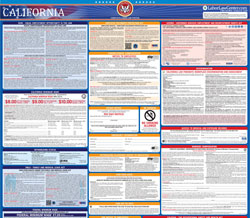 California Required Workday Break & Meal Periods 2026
California Required Workday Break & Meal Periods 2026
Workday Meal Periods:
REQUIRED
By Administratively issued Industrial Welfare Commission Orders, and California Labor Code section 512.
Workday Rest Periods:
REQUIRED
By Administratively issued Industrial Welfare Commission Orders.
California has extensive regulations providing for mandatory break periods during the workday, including both mandatory meal / lunch periods and one or more shorter rest periods. This page provides details about California's meal and rest period requirements.
Mandatory Workday Lunch / Meal Breaks in California
California requires that employees be allowed a ½ hour lunch period, after 5 hours of work, except when workday will be completed in 6 hours or less and there is mutual employer/employee consent to waive the meal period.
An on-duty meal period counted as time worked and permitted only when nature of work prevents relief from all duties and there is written agreement between parties. Employee may revoke agreement at any time.
An employee may not be required to work for more than 10 hours unless they are provided with a second meal period of not less than 30 minutes. If the total hours worked is no more than 12 hours, the second meal period may be waived by mutual consent of the employer and employee as long as the first meal period was not waived.
The Industrial Welfare Commission may adopt working condition orders permitting a meal period to start after 6 hours of work if the commission determines that the order is consistent with the health and welfare of the affected employees.
Which employees are covered by California's meal period regulations?
California's lunch break rules are applied uniformly to all industries under 14 Orders, including agriculture and private household employment. There are several exceptions, as follows:
Lunch break rules exempt employees in the wholesale baking industry who are subject to an Industrial Welfare Commission Wage Order and who are covered by a valid collective bargaining agreement that provides for a 35-hour workweek consisting of five 7-hour days, overtime payment of 1 and ½ times the regular rate of pay for time worked in excess of 7 hours per day, and a rest period of not less than 10 minutes every 2 hours.
Exceptions also apply to the motion picture or broadcasting industries pursuant to Labor Code sections 512 and 226.7, and Industrial Welfare Commission Wage Orders 11 and 12.
California law also exempts construction workers, private security officers, commercial drivers, and employees of utility companies if the employees are covered by a valid collective bargaining agreement. To be considered valid, the agreement must provide for the wages, hours of work, and working conditions of employees, and expressly provide for meal periods for those employees, final and binding arbitration of disputes concerning application of its meal period provisions, premium wage rates for all overtime hours worked, and a regular hourly rate of pay of not less than 30 percent more than the state minimum wage rate.
Note: California Has Special Regulations for Minor Employees
In addition to a general regulation requiring meal periods for employees, California has special regulations that require meal periods for minors under age 18. These regulations, which require more frequent and / or longer meal / break periods, take precedence over the general regulations for minor employees. Learn more about California's child labor regulations here.
Mandatory Workday Rest Periods in California
In California, a paid 10-minute rest period is required for each 4 hours worked (or major fraction thereof). If possible, this rest period should be in the middle of each work period. A rest period is not required for employees whose total daily work time is less than 3 and ½ hours.
Which employees are covered by California's rest period regulations?
California's rest period rules have uniform application to industries under 15 Orders, including agriculture and household employment. Rest period rules exclude professional actors, sheepherders under the Agricultural Occupations Order, and personal attendants under the Household Occupations Order.
Additional Rest Period Information
Additional interim rest periods are required in the motion picture industry during actual rehearsal or shooting for swimmers, dancers, skaters or other performers engaged in strenuous physical activity.
Under all Orders, except for private household employment, the Division of Labor Standards Enforcement may grant an exemption to these rest period rules upon employer application on the basis of undue hardship, if such an exemption would not materially affect the welfare or comfort of employees.
Get a California all-in-one labor law poster 
Instead of printing out pages of mandatory California and Federal labor law posters, you can purchase a professional, laminated all-in-one labor law poster that guarantees compliance with all California and federal posting requirements. Fully updated for January 2017!
Get All-In-One Poster Now
